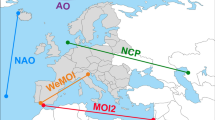Abstract
The droughts of north-east Brazil are unusually well defined in the departures of the quasi-permanent circulation systems in the tropical Atlantic sector. Anomaly patterns in the large-scale atmospheric and oceanic fields evolve in the course of the half-year preceding the March/April rainy season. Based on these diagnostic results, dynamically plausible predictor candidates are selected and entered into a stepwise multiple regression scheme. The circulation in the Atlantic sector proves to be essential for the prediction of rainfall anomalies, while predictor candidates from other parts of the globe are of subordinate importance. The regression equations derived from the 1921–56 record are used to produce rainfall forecasts for the years 1958–72. Forecast and observed values are strongly correlated. In particular, the severe 1958 drought was eminently predictable from this method.
This is a preview of subscription content, access via your institution
Access options
Subscribe to this journal
Receive 51 print issues and online access
$199.00 per year
only $3.90 per issue
Buy this article
- Purchase on Springer Link
- Instant access to full article PDF
Prices may be subject to local taxes which are calculated during checkout
Similar content being viewed by others
References
Workshop on drought forecasting for Northeast Brazil, INPE, February 1980 (Conselho Nacional de Pesquisas, São José dos Campos, 1980).
Namias, J. Tellus 24, 336–343 (1972).
Hastenrath, S. & Heller, L. Q. Jl Roy. met. Soc., 103, 77–92 (1977).
Hastenrath, S. & Lamb, P. J. Climatic Atlas of the Tropical Atlantic and Eastern Pacific Oceans (University of Wisconsin Press, Madison, 1977).
Covey, D. C. & Hastenrath, S. Mon. Weath. Rev. 106, 1280–1287 (1978).
Markham, C. G. & McLain, D. R. Nature 265, 320–323 (1977).
Moura, A. D. & Shukla, J. J. atmos. Sci. 38, 2653–2675 (1981).
Hastenrath, S., Wu, M. C. & Chu, P. S. Q. Jl R. met. Soc. (submitted).
Observacões pluviométricas no Nordeste do Brazil (Departamento Nacional de Obras contra as Secas, Brazil, 1969).
Hastenrath, S. & Rosen, A. Tellus, 35A, 324–331 (1983).
Wright, P. B. An Index of the Southern Oscillation (Climatic Research Unit, University of East Anglia, Res. Publ. 4, 1975).
Wright, P. B. The Southern Oscillation—Patterns, and Mechanisms of the Teleconnections and the Persistence HIG-77-13, 107 (Hawaii Institute of Geophysics, 1977).
Draper, N. R. & Smith, H. Applied Regression Analysis (Wiley, New York, 1981).
STATJOB Summary (Academic Computing Center, University of Wisconsin, Madison, 1980).
Panofsky, H. A., & Brier, G. W. Some Applications of Statistics to Meteorology 191–208 (Pennsylvania State University, 1968).
Preisendorfer, R. W. & Mombley, C. D. Climate Forecast Verifications, U.S. Mainland, 1974-82 (NOAA Tech. Mem. ERL PMEL-36, Seattle, 1982).
Quenouille, M. H. Associated Measurements (Butterworths, London, 1952).
Author information
Authors and Affiliations
Rights and permissions
About this article
Cite this article
Hastenrath, S. Predictability of north-east Brazil droughts. Nature 307, 531–533 (1984). https://doi.org/10.1038/307531a0
Received:
Accepted:
Issue Date:
DOI: https://doi.org/10.1038/307531a0
This article is cited by
-
Unprecedented drought over tropical South America in 2016: significantly under-predicted by tropical SST
Scientific Reports (2017)
-
Predictability of anomalous river discharge in Guyana
Nature (1990)
-
Temporal and spatial variability of SSTs in the tropical Atlantic and Indian Oceans
Meteorology and Atmospheric Physics (1990)
-
Spectral characteristics of the annual rainfall series for Northeast Brazil
Climatic Change (1988)
-
Are droughts predictable?
Climatic Change (1986)
Comments
By submitting a comment you agree to abide by our Terms and Community Guidelines. If you find something abusive or that does not comply with our terms or guidelines please flag it as inappropriate.



